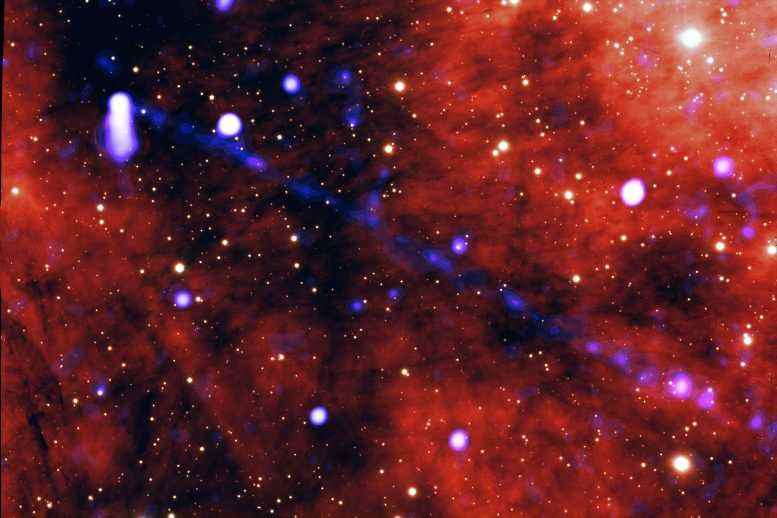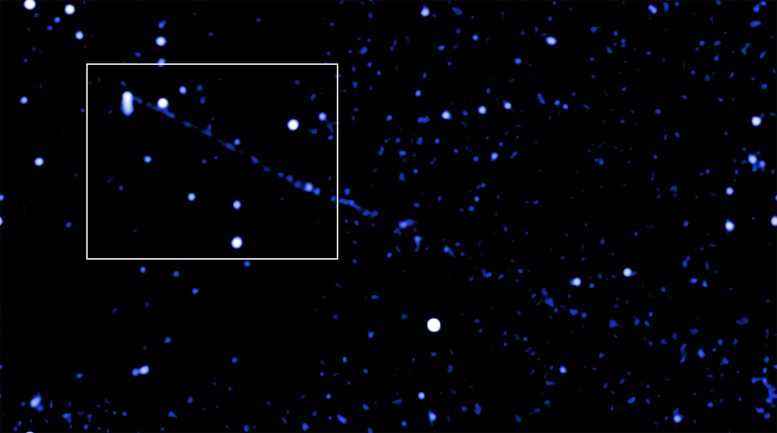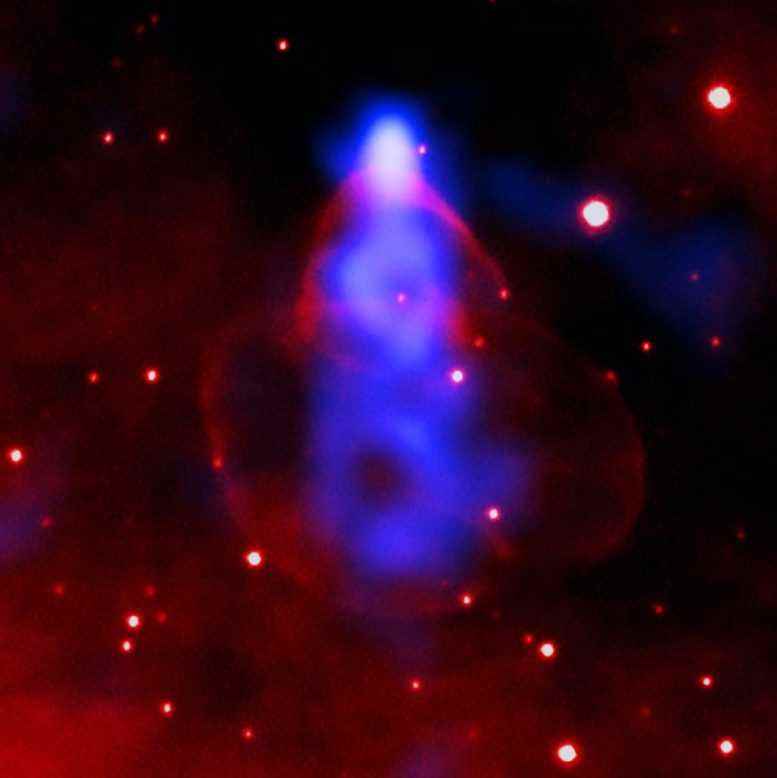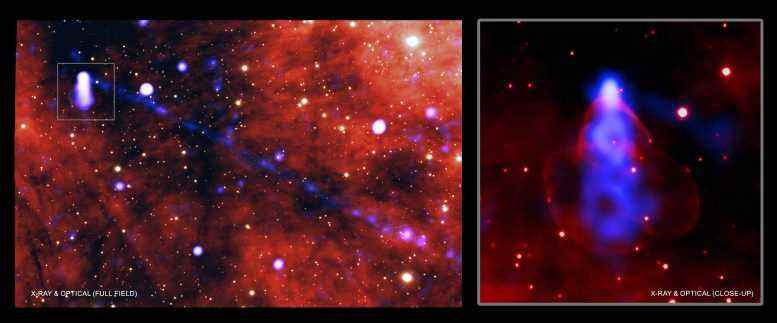J2030 Röntgen ve Optik. Kredi: Röntgen: NASA/CXC/Stanford Üniv./M. de Vries; Optik: NSF/AURA/Gemini Konsorsiyumu
- Şehir büyüklüğünde çökmüş bir yıldız, trilyonlarca mil boyunca uzanan bir madde ve antimadde ışını üretti.
- Veriler[{” attribute=””>NASA’s Chandra X-ray Observatory revealed the full extent of this beam, or filament.
- This discovery could help explain the presence of positrons detected throughout the Milky Way galaxy and here on Earth.
- Positrons are the antimatter counterpart to the electron.
NASA’nın Chandra X-ışını Gözlemevi’nden ve yer tabanlı optik teleskoplardan alınan bu görüntü, nispeten küçük bir nesneden uzanan madde ve antimaddeden oluşan son derece uzun bir ışını veya filamanı göstermektedir.[{” attribute=””>pulsar. With its tremendous scale, this beam may help explain the surprisingly large numbers of positrons, the antimatter counterparts to electrons, scientists have detected throughout the Milky Way galaxy.
In the image at the top of the page, the panel on the left displays about one third the length of the beam from the pulsar known as PSR J2030+4415 (J2030 for short), which is located about 1,600 light years from Earth. J2030 is a dense, city-sized object that formed from the collapse of a massive star and currently spins about three times per second. X-rays from Chandra (blue) show where particles flowing from the pulsar along magnetic field lines are moving at about a third the speed of light. A close-up view of the pulsar in the right panel shows the X-rays created by particles flying around the pulsar itself. As the pulsar moves through space at about a million miles an hour, some of these particles escape and create the long filament. In both panels, optical light data from the Gemini telescope on Mauna Kea in Hawaii have been used and appear red, brown, and black. The full length of the filament is shown in a separate image (below).

J2030 X-Ray and Optical wide fieldCredit: NASA/CXC/Stanford Univ./M. de Vries
The vast majority of the Universe consists of ordinary matter rather than antimatter. Scientists, however, continue to find evidence for relatively large numbers of positrons in detectors on Earth, which leads to the question: what are possible sources of this antimatter? The researchers in the new Chandra study of J2030 think that pulsars like it may be one answer. The combination of two extremes — fast rotation and high magnetic fields of pulsars — lead to particle acceleration and high energy radiation that creates electron and positron pairs. (The usual process of converting mass into energy famously determined by Einstein’s E = mc2 equation is reversed, and energy is converted into mass.)

J2030 X-Ray full field. Credit: NASA/CXC/Stanford Univ./M. de Vries
Pulsars generate winds of charged particles that are usually confined within their powerful magnetic fields. The pulsar is traveling through interstellar space at about half a million miles per hour, with the wind trailing behind it. A bow shock of gas moves along in front of the pulsar, similar to the pile-up of water in front of a moving boat. However, about 20 to 30 years ago the bow shock’s motion appears to have stalled and the pulsar caught up to it.

J2030 X-Ray and Optical close-up. Credit: X-ray: NASA/CXC/Stanford Univ./M. de Vries; Optical: NSF/AURA/Gemini Consortium
The ensuing collision likely triggered a particle leak, where the pulsar wind’s magnetic field linked up with the interstellar magnetic field. As a result, the high-energy electrons and positrons could have squirted out through a “nozzle” formed by connection into the Galaxy.
Daha önce, gökbilimciler, enerjik pozitronların genellikle Galaksi’ye sızmakta zorlandıklarını ima eden gama ışını ışığında yakındaki pulsarların etrafında büyük haleler gözlemlemişti. Bu, pulsarların bilim adamlarının saptadığı pozitron fazlalığını açıkladığı fikrini alt üst etti. Bununla birlikte, J2030 gibi yakın zamanda keşfedilen pulsar filamentleri, parçacıkların aslında yıldızlararası uzaya kaçabileceğini ve sonunda Dünya’ya ulaşabileceğini gösteriyor.
Bu keşif hakkında daha fazla bilgi için bkz. Minik Yıldız, 40 Trilyon Mil Uzanan Gargantuan Işını ve Anti-Maddeyi Serbest Bırakıyor.
Referans: “The Long Filament of PSR J2030+4415”, Martijn de Vries ve Roger W. Romani, Kabul Edildi, Astrofizik Dergisi.
arXiv:2202.03506
Stanford Üniversitesi’nden Martjin de Vries ve Roger Romani tarafından yazılan bu sonuçları açıklayan bir makale, Astrofizik Dergisi. NASA’nın Marshall Uzay Uçuş Merkezi, Chandra programını yönetiyor. Smithsonian Astrofizik Gözlemevi’nin Chandra X-ray Merkezi, Cambridge, Massachusetts’teki bilim operasyonlarını ve Burlington, Massachusetts’teki uçuş operasyonlarını kontrol ediyor.

